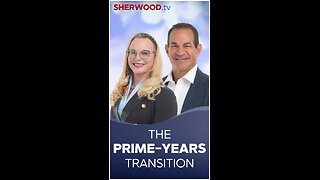Premium Only Content

How America’s housing crisis changed ‘affordable housing’
America's housing crisis has changed the tune of how people perceive affordable housing, according to a new survey.
The poll of 1,000 U.S. adults found more than half believe what they pay monthly for their home is more than it should be — the average person stating they spend 42% of their annual income on housing-related costs.
More than four in 10 (42%) parents polled in the survey said they either don't believe or "aren't sure" their children would be able to afford living in the same neighborhood they're growing up in, due to climbing housing costs.
And many who said they pay more than they should blame the surrounding environment: 45% cite their neighborhood's cost of living is higher than average, and another 33% noted that where they live is "notorious" for high housing costs.
All of this has led people to consider affordable housing as the possible solution.
Commissioned by Built and conducted by Talker Research, the study found 63% view "affordable housing," as a term positively.
In fact, more people viewed affordable housing positively than other forms of multi-family housing (83%, compared to townhomes (76%), apartments (70%) and mobile or pre-fabricated homes (64%)).
While people believe affordable housing is defined as being extremely low-cost (38%), synonymous with public housing (33%) or is exclusively for people living under the poverty line (23%), one in three Americans believe affordable housing is meant for anyone and everyone.
Others believe it's intended for low-income people (44%), retirees and seniors (29%), veterans (22%) and first-time buyers/renters (19%).
Two-thirds said they'd be willing to live in or next to a home labeled "affordable housing" and another 53% would react positively if the house or building next to them was converted to affordable housing.
“Affordability challenges have gone mainstream,” said Chase Gilbert, CEO of Built. “More people are realizing affordable housing isn’t about charity — it’s about keeping the American dream within reach. Homeownership has always been a cornerstone of that dream, and for too many, that path is getting harder to find.”
The study also found 73% of Americans believe it's important where they live to have plenty of available housing options, and a similar 74% believe all housing costs should be completely stabilized.
But 41% believe their local city doesn't have enough housing to meet people's needs.
Two in three (65%) said they'd likely support new housing being built in their neighborhood, and many believe it's the responsibility of state governments (45%), local governments (44%) and the federal government (36%) to solve their city's housing crisis.
When asked what housing-related policies they support, respondents were most in favor of converting surplus buildings like offices or warehouses into housing (45%), new developments should be required to include a certain amount of affordable units (42%) and that tax incentives should be given for neighborhoods that add more housing (34%).
“Policy decisions are definitely a part of the equation, but there’s more to it than that,” explained Gilbert. “Even if funding for new buildings is unlocked, it must flow into real projects for construction to begin. Capital that doesn’t move is no different than capital that was never there.”
Survey methodology:
Talker Research surveyed 1,000 Americans, split equally by political alignment and split by age along national representation; the survey was commissioned by Built and administered and conducted online by Talker Research between July 24 and July 28, 2025.
We are sourcing from a non-probability frame and the two main sources we use are:
● Traditional online access panels — where respondents opt-in to take part in online market research for an incentive
● Programmatic — where respondents are online and are given the option to take part in a survey to receive a virtual incentive usually related to the online activity they are engaging in
Those who did not fit the specified sample were terminated from the survey. As the survey is fielded, dynamic online sampling is used, adjusting targeting to achieve the quotas specified as part of the sampling plan.
Regardless of which sources a respondent came from, they were directed to an Online Survey, where the survey was conducted in English; a link to the questionnaire can be shared upon request. Respondents were awarded points for completing the survey. These points have a small cash-equivalent monetary value.
Cells are only reported on for analysis if they have a minimum of 80 respondents, and statistical significance is calculated at the 95% level. Data is not weighted, but quotas and other parameters are put in place to reach the desired sample.
Interviews are excluded from the final analysis if they failed quality-checking measures. This includes:
● Speeders: Respondents who complete the survey in a time that is quicker than one-third of the median length of interview are disqualified as speeders
● Open ends: All verbatim responses (full open-ended questions as well as other please specify options) are checked for inappropriate or irrelevant text
● Bots: Captcha is enabled on surveys, which allows the research team to identify and disqualify bots
● Duplicates: Survey software has “deduping” based on digital fingerprinting, which ensures nobody is allowed to take the survey more than once
It is worth noting that this survey was only available to individuals with internet access, and the results may not be generalizable to those without internet access.
-
 0:46
0:46
SWNS
6 days agoEmpty nest? What parenting looks like after they leave
15 -
 7:30
7:30
Blackstone Griddles
12 hours agoEasy Weeknight Meals: Meatloaf Sliders on the Blackstone Griddle
2.45K2 -
 8:47
8:47
DropItLikeItsScott
14 hours ago $0.89 earnedDid HI-POINT Just Create The Next Best AR? Hi-Point HP15 AR-15 Pistol
4K1 -
 39:19
39:19
The Heidi St. John Podcast
3 days agoFirst Fan Mail Friday: From the White House to Your Questions
4.17K3 -
 LIVE
LIVE
BEK TV
22 hours agoTrent Loos in the Morning - 9/23/2025
209 watching -
 24:12
24:12
Michael Feyrer Jr
22 hours agoWe Stream to TikTok! How we did it! Week 2 #Stream10k
3.89K1 -
 35:33
35:33
Anthony Rogers
16 hours agoBourbon and Beyond (2025)
4.9K1 -
 33:30
33:30
The Bryce Eddy Show
4 days ago $0.03 earnedMonty Bennett: HERO Model to Fight Crime
8.15K3 -
 0:41
0:41
Living Your Wellness Life
3 days agoThe Prime-Years Transition
6.39K -
 LIVE
LIVE
The Bubba Army
21 hours agoJimmy Kimmel's Back - Bubba the Love Sponge® Show | 9/23/25
2,015 watching